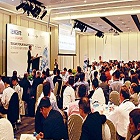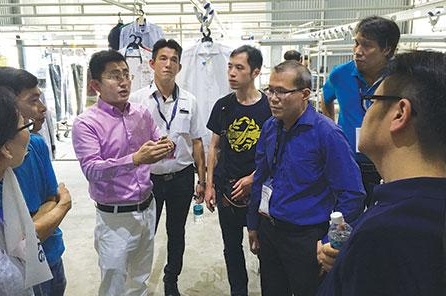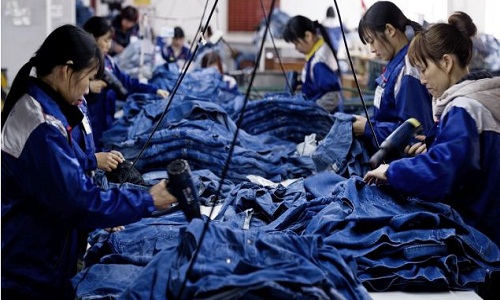FW
"Texcare Forum Singapore, an affiliated event of Texcare Asia, wrung down its curtains on November 10 having started on November 9 on a successful note. The event welcomed more than 200 delegates from 11 countries and regions, reports show organizers Messe Frankfurt (Shanghai) Co. Ltd. and the China Light Industry Machinery Association. "

Texcare Forum Singapore, an affiliated event of Texcare Asia, wrung down its curtains on November 10 having started on November 9 on a successful note. The event welcomed more than 200 delegates from 11 countries and regions, reports show organizers Messe Frankfurt (Shanghai) Co. Ltd. and the China Light Industry Machinery Association.
Forum
The Forum took place here on both the days. It consisted of a full-day conference that addressed market conditions on Southeast Asia. It also addressed the demands as well as a factory visit to three local laundry plants.

Said Richard Li, general manager of Messe Frankfurt (Shanghai) Co. Ltd. that the Texcare Forum is an integral part of Texcare Asia that is renowned for offering a wealth of opportunities through business networking and knowledge exchange. In the past, similar events were successfully held in Hong Kong and Macau to connect industry players and foster understanding of the two cities’ laundry markets, he added.
This year’s Forum was strategically held in Singapore. The synergistic collaboration of both the exhibition and Forum under the Texcare brand encouraged industry peers to capitalize on market opportunities and reshape the business agenda of the industry altogether. The organisers said that the Forum was supported by the Singaporean government. Lim Swee Say, the government’s minister for manpower, was the guest of honor. Say shared the current industry conditions and challenges posed by the progressive shortage in manpower and an aging workforce, according to organizers.
The event was also fostered by two Singaporean organizations viz the Employment and Employability Institute (e2i) and the TCA Textile Care Training Centre, as well as backed by VDMA Garment and Leather Technology from Germany. In all, more than 200 local and international industry professionals from equipment manufacturers, laundry and drycleaning businesses, hotel and healthcare sectors, research institutes and public agencies were in attendance.
Representing the commercial laundry business in Singapore, Poh Wee Yong, assistant general manager, projects and engineering, of Systematic Laundry & Uniform Services Pte. Ltd., shared his insights on the topic of Reinventing Laundry Business with RFID Technology. He was impressed by the results, say organisers.
Young divulged that it was their pleasure to give a presentation on his company’s views at Texcare Forum Singapore which is so well organised. Besides delivering The panel discussion also encouraged them to set goals of what needs to be established now.

In addition to the focus on the Singapore market, the Forum called upon speakers from the Philippines, Texcare Forum concludes in Singapore Indonesia and Malaysia to deliver the market overview of their respective countries. Among others Virgilio Sia, chairman and CEO of Versia Corp. of the Philippines was one of the members who spoke out.
Along with the Forum, a networking area was set up in the neighbouring hall to offer manufacturers and sales agents an extended sales opportunity, organizers informed. Long-term exhibitor at Texcare Asia, Jiangsu Sea-lion Machinery Group (Corp.) from China also signed up for this event.
Next location of Texcare Asia
After Singapore, Shanghai will once again become the focus of the international laundry and dry cleaning industry, as the next edition of Texcare Asia would take place in Shanghai from September 27 to 29, 2017. The fair is expected to occupy an expansive space of almost 183,000 square feet, housing around 160 exhibitors from around the world, say show organizers. Texcare Asia is a biennial event organized by Messe Frankfurt (Shanghai) Co. Ltd. and the China Light Industry Machinery Association. It is also a sister event of Texcare International.
In its bid to help the country’s apparel exporters widen their export markets, the Sri Lanka Apparel Exporters Association (SLAEA) has urged the Government to explore the possibility of signing more trade agreements especially with countries such as Japan, Russia, Korea, Brazil and South Africa. Such agreements will help the apparel industry to broaden its export base and bring in valuable foreign exchange, industry officials feel. After GSP+ is restored, the industry has made a commitment to the Government to increase exports to the EU by US$ 500 million annually.
Said the new Chairman of SLAEA, Felix A. Fernando, Sri Lanka’s position is that the restoration will give some room to breathe and consolidate the industry. The GSP+ benefit Sri Lanka will enjoy for the next three or four years can be used to accomplish many other medium and long term goals which will not only be beneficial to the apparel industry but boost all the exports from our country. Sri Lanka should seriously consider negotiating a trade agreement with the EU, as the GSP+ can beenjoyed for a maximum of 4-5 years at most.
Speaking at the Annual General Meeting of the Association, Fernando said that it was the need of everyone to find and diversify into new markets for exports. Considering the reputation Sri Lanka has for its quality and Sri Lanka’s inability to compete on the low-end value products which are made in neighbouring South Asian countries, the country must increase the production of higher value-added products, such as formal wear and high-end outerwear.
This year, high domestic prices have forced the industry to begin the import of cotton early. In December, already about 3 lakh bales of the commodity have been imported. Usually, imports start around April/May when domestic prices start escalating.
However, this year as arrival of cotton has fallen post the note-ban and farmers are not selling cotton in a big way as they prefer to deal in cash, the prices og the commodity have firmed up to Rs 39,000 per candy of 355 kg in the domestic market. According to Cotton Corporation of India (CCI) data, season’s total arrival from October to December so far has reached 7.5 million bales, denoting a drop compared to the 10 million bales in 2015. Mills of South India are importing cotton from West Africa as it is comparatively cheaper than Indian cotton by almost Rs 6,000-7,000 per candy.
According to industry sources, cotton prices may not fall in the near future as daily arrival is still below expectation. Currently, cotton arrival has registered at 150,000 bales a day where it should be about 225,000 bales at this time of the season.
Briefed Shirish Shah of Bhaidas Karsandas Company and member of Cotton Association of India (CAI), post demonetisation, prices of cotton have gone up and against it, supply has decreased as farmers are not selling cotton in a big way. Note ban created cash shortage and as most of the farmers prefer to deal in cash, it disturbed the arrival of the commodity. On the other hand, international prices are ruling lower than domestic cotton prices. This has encouraged the mills to import early this year.
After demonetisation, several mandis are also not fully operational, as arrivals have come down. Short arrival at the time of peak season helped escalate the cotton prices to Rs 39,000 per candy. Internationally, cotton prices are being quoted at Rs 33,500 per candy.
SewSporty, a California athletic apparel manufacturer, has acquired Stonewear, a Louisville-based women’s apparel brand. Founded in Boulder in 1996, Stonewear was acquired by Great Trango Holdings, a family of privately held climbing brands in 2001.
Michael Gilstrap, president and CEO of SewSporty said in a statement that the acquired company has established strong market share and it is the belief of his company that the brand has potential to further maximize results with a dedicated manufacturing partner. It’s a natural fit given the capacity of SewSorty’s facility in Vista, California that enables Stonewear to continue manufacturing in the USA. Stonewear will continue to be based and designed in Louisville, according to a statement from SewSporty.
"FT Confidential Research's latest quarterly brand survey reveals the growing popularity in second- and third-Tier cities is cementing the leading position of Uniqlo, H&M and Zara in China. Companies are aggressively expanding their base in China, despite the ongoing economic slowdown. Therefore, Chinese brands are finding it difficult to sustain their momentum. The latest consumer brands survey found Uniqlo remains the most popular casual wear brand among China's urban consumers, with 19.3 per cent of respondents saying it was one of the two brands they most regularly purchased, up 1.9 percentage points from the fourth quarter of 2015."
 FT Confidential Research's latest quarterly brand survey reveals the growing popularity in second- and third-Tier cities is cementing the leading position of Uniqlo, H&M and Zara in China. Companies are aggressively expanding their base in China, despite the ongoing economic slowdown. Therefore, Chinese brands are finding it difficult to sustain their momentum. The latest consumer brands survey found Uniqlo remains the most popular casual wear brand among China's urban consumers, with 19.3 per cent of respondents saying it was one of the two brands they most regularly purchased, up 1.9 percentage points from the fourth quarter of 2015.
FT Confidential Research's latest quarterly brand survey reveals the growing popularity in second- and third-Tier cities is cementing the leading position of Uniqlo, H&M and Zara in China. Companies are aggressively expanding their base in China, despite the ongoing economic slowdown. Therefore, Chinese brands are finding it difficult to sustain their momentum. The latest consumer brands survey found Uniqlo remains the most popular casual wear brand among China's urban consumers, with 19.3 per cent of respondents saying it was one of the two brands they most regularly purchased, up 1.9 percentage points from the fourth quarter of 2015.
Spreading wings in Tier II cities

The popularity of fast-fashion brands has now spread beyond China's richest urban centres. Uniqlo is well-Fast fashion brandsestablished in China's Tier-I cities -- 24.9 per cent of these respondents selected the brand - with much of its improvement in our latest survey coming from second- and third-tier city respondents. Brand popularity rose 3.7 percentage points in second-tier cities compared with our last survey at the end of 2015, and 2.4 percentage points in third-tier cities. H&M and Zara, meanwhile, secured second and third place in first-tier cities, with their overall popularity rising 2.7 and 1.5 percentage points respectively since our last survey. H&M's brand popularity rose most sharply in second-tier cities, up 4 percentage points, while Zara's rose 3.5 percentage points in this city tier.
On an aggressive footing
Uniqlo's parent company, Fast Retailing, operated 472 stores in China at the end of August, up from 387 a year prior and plans to open 100 stores a year in China, including those of youth-oriented brand GU, until it hits 1,000 stores. It eventually hopes to raise its store count to 3,000. China contributes half of its global revenues. Sweden's H&M added 47 new stores within the first nine months of this year, bringing its total store count to 400. Inditex's Zara brand was the most conservative of the three, with its store count rising by just nine in that period, bringing its total to 188.
Despite their growing popularity, these brands have not been immune to China's broader economic slowdown. Uniqlo's greater China sales rose 9.3 per cent year-on-year to 332.8 bn yen ($2.9bn) in fiscal year 2016, a sharp decline from 46.3 per cent the previous year, while operating profits slipped 5.5 percent year-on-year to 36.5bn yen. H&M's China sales growth also slid, falling from 16 per cent last year to 5 per cent year-on-year in the first nine months of 2016.
Is rapid expansion sure success formula?
Analysts feel that although their popularity is increasing, it remains to be seen if lower-tier city demand will be sufficient to justify such rapid store count growth. Urban disposable incomes in the provinces can be roughly half those of Beijing and Shanghai, while FT’s monthly survey of Chinese households across all city tiers has consistently found sentiment towards clothes buying in lower-tier cities weaker than that of higher tiers. These companies may pride themselves on the affordability of their product, but a Uniqlo down jacket still costs around Rmb160 ($23) more than one sold by Shanghai-based Metersbonwe, which held on to second place overall in the brand survey.
Cashmere Luxury brand Sand River has entered the US market with an aim to offer complementary shipping to its US customers from its Shanghai location within four days and a local US-based return policy. The fashion brand currently operates eleven boutiques in Asia and has a worldwide e-commerce presence through its website Sand River Cashmere.
Sand River counters the current fast fashion trend by guaranteeing genuine, high-quality and long-lasting cashmere products which are sourced directly from the grasslands of the Alashan Plateau of Inner Mongolia thus refusing to meet the demands of today's mass-produced markets by compromised quality. Quality, tradition and comprehensive sustainable practices are thus imperative for the company that has been active in the international fashion scene since 2007 and has been present at major fashion shows in Tokyo and Paris.
Sand River has put together a creative team of international designers and artists that spans the globe including world-renowned Japanese designer and multiple fashion award recipient Junko Koshino, French-Columbian artist Francesca Brenda-Mitterrand and fashion designers Antje Weidner and Qin Wanyu from Germany and China, respectively.
Animal lovers can also wear Sand River's products without compromising their standards, given that all products are made of 100 percent pure and sustainably sourced cashmere: The brands own sourcing base of 30 local herding families, some of whom operate on Guo family-owned grasslands, are treated with utmost care and respect, including the goats.
Though it is peak season for Varanasi’s silk weavers, but showrooms across the holy city wears a deserted look as footfalls have thinned thanks to the currency crunch that has affected the silk weaving sector. Not only that, the manufacturing units too is deserted and the cranking looms have gone silent.
So much is the effect of demonetization that Silk emporiums have seen production drop by 50 per cent with demand down by a similar percentage. The existing stocks are being sold at significantly cheaper prices as they are desperate for liquid cash to pay weavers.
Since, people are unable to withdraw more than Rs. 50,000 a week, emporium owners cannot buy raw material or pay their labourers. Though some weavers supply sarees to the rest of India, demand from other big cities has dwindled and is down by half.
The plight of the smaller weavers, who sub-contract work for the bigger players, is even worse. But the worst hit are clearly the weavers. Currently, there are more than 30,000 daily wagers who work as weavers for a mere Rs 300 a day.
As manufacturers moved to lower-wage countries such as Vietnam, India and Bangladesh to do more of their production, the US imported fewer clothes from China this year than last year. Still, China accounted for 35 per cent of the apparel imported into the US for the 12-month period that ended on October 31. In last few years, China has accounted for as much as 40 per cent of all clothing brought into the country.
The U.S. Commerce Dept. reported that apparel goods coming in from China were down nearly 7 per cent in the one-year period to $28.35 billion. As salaries are rising in Chinese factories, U.S. clothing companies were seen moving production to countries that had lower wages. The most favored country for apparel making after China is now Vietnam that has grown steadily over the years with more apparel factories coming online.
Apparel imports to the US from Vietnam grew 3.7 per cent in the one-year period ending October 31 totaling $10.75 billion. This accounted for 13 per cent of all apparel imported into the United States.
Bangladesh is also growing in importance when it comes to apparel manufacturing. Big retailers such as H&M and Zara have consistently headed to this extremely low-wage country to have goods produced in big factories.
For the one-year period ending in October, Bangladesh exported $5.3 billion worth of clothing to the United States, making up about 6.5 percent of total apparel imports. That was about the same as the previous year. India only exported $3.65 billion worth of apparel to the United States, but when factoring in fabric and other textiles, the total jumped to $7.2 billion in goods.
Zara will launch a fund for workers in Turkey. These 140 workers were at a factory that closed down without warning. They will be reimbursed for unpaid wages, severance pay and unused vacation time. The popular fast fashion retailer faced criticism when shoppers at an outlet noticed tags attached to garments. These tags were put by unpaid workers, who spelt out their plight in messages.
The total for the 140 workers left with three months of unpaid wages amounts to only 0.01 per cent of Zara’s annual sales. Homegrown brand Zara leads the fashion industry in Spain. Zara is the flagship brand of the Inditex Group. Inditex, which has a market capitalization of 113 billion dollars, is one of the world's largest fashion retailers. It owns 7,405 stores and employs 1,62,450 people. The company has helped to reshape the fashion industry with its ability to quickly produce and turnaround cheaper fashion items.
Some of the world’s biggest brands source garments from Turkey. Among them are Primark, Inditex and H&M. It can be difficult for brands to know exactly what their suppliers are doing. Factories may subcontract work without a brand’s knowledge to meet tight deadlines and Turkey’s proximity to Europe makes it convenient for fulfilling last-minute orders.
A conference titled ‘Cotton2Cloth: Transparency in the Apparel Industry’ was held in Negombo, Sri Lanka from December 5 to 8. The event brought together 57 participants from 12 countries with participants looking at how to use transparency to improve working conditions in the apparel industry. The need for greater transparency in apparel supply chains was the subject of a meeting which brought together representatives from apparel manufacturers, brands and retailers as well as government NGOs and textile industry workers.
Leslie Johnston, executive director of the C&A Foundation said that transparency is a core pillar of C&A Foundation's work. RGE Foundation believes that it can bring about accountability and transform the fashion industry into a force for good. C& A Foundation co-hosted the Sri Lanka-based event along with Humanity United, Open Society Foundations and Transparentem. The meeting was held under Chatham House Rule. However, there were some interesting observations about how a lack of transparency in supply chains is not conducive to sustainability.












